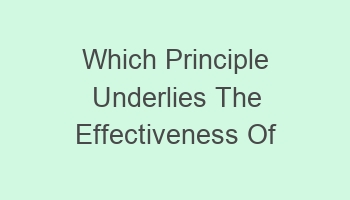Which Principle Underlies The Effectiveness Of Systematic Desensitization?

The principle that underlies the effectiveness of systematic desensitization is known as reciprocal inhibition. This technique involves pairing relaxation with anxiety-inducing stimuli to gradually reduce fear responses. Developed by psychologist Joseph Wolpe, systematic desensitization works by replacing fear responses with relaxation responses. By repeatedly exposing individuals to feared situations while promoting relaxation, the brain learns to associate calmness with previously anxiety-provoking stimuli. This process helps individuals overcome phobias, anxiety disorders, and other fear-based issues. Reciprocal inhibition works by inhibiting fear responses through relaxation techniques, ultimately leading to a reduction in anxiety levels. Systematic desensitization is a widely used and effective therapy for treating various anxiety disorders.
Contents
| Systematic desensitization helps reduce anxiety through gradual exposure to feared stimuli. |
| Principle: Counterconditioning replaces fear response with relaxation response. |
| Exposure hierarchy assists in creating a step-by-step plan for facing fears. |
| Gradual exposure: Slowly increasing exposure to feared stimuli reduces anxiety. |
| Relaxation techniques like deep breathing help maintain calmness during exposure. |
- Fear hierarchy guides treatment by ranking anxiety-inducing situations.
- Behavioral therapy: Systematic desensitization is a form of behavioral therapy.
- By associating relaxation with fear, desensitization weakens fear response.
- Technique can be applied to various anxiety disorders, phobias, and PTSD.
- Therapist guidance is essential for effective implementation of systematic desensitization.
What Is the Principle Behind the Effectiveness of Systematic Desensitization?
Systematic desensitization is a behavioral therapy technique used to help individuals overcome phobias and anxieties. The principle underlying its effectiveness is based on the concept of counterconditioning. This means that by pairing a relaxation response with a fear-inducing stimulus, individuals can learn to replace their fear response with a more relaxed one.
- Counterconditioning involves replacing an unwanted response (fear) with a desired response (relaxation).
- Systematic desensitization is often used to treat phobias, PTSD, and other anxiety disorders.
- It is a gradual process that involves creating a hierarchy of fear-inducing stimuli and gradually exposing the individual to them.
Why Is Counterconditioning Important in Systematic Desensitization?
Counterconditioning plays a crucial role in systematic desensitization because it helps individuals reframe their fear response. By associating relaxation with the feared stimulus, individuals can learn to respond differently when faced with that stimulus in the future.
| Counterconditioning | Replaces fear response with relaxation |
| Helps individuals overcome phobias and anxieties | By changing their conditioned responses |
How Does Systematic Desensitization Help Individuals Overcome Phobias?
Systematic desensitization aids individuals in overcoming phobias by gradually exposing them to feared situations or objects in a controlled and systematic manner. This process helps individuals learn to manage their anxiety and fear responses, ultimately reducing or eliminating their phobic reactions.
- Exposure hierarchy is created to gradually desensitize individuals to feared stimuli.
- Relaxation techniques are taught to help individuals cope with anxiety during exposure.
- Repeated exposure helps individuals reframe their perception of feared stimuli.
When Is Systematic Desensitization Most Effective in Treating Anxiety Disorders?
Systematic desensitization is most effective in treating anxiety disorders when used in conjunction with other therapeutic techniques, such as cognitive-behavioral therapy. It is particularly beneficial for individuals with specific phobias, social anxiety disorder, and PTSD.
| Combining systematic desensitization with cognitive-behavioral therapy | Enhances treatment outcomes for anxiety disorders |
| Effective for treating specific phobias and social anxiety disorder | By targeting specific fears and anxiety triggers |
Which Factors Influence the Success of Systematic Desensitization?
Several factors can influence the success of systematic desensitization, including the individual’s willingness to participate, the expertise of the therapist, and the level of support available during the treatment process. Additionally, the complexity and severity of the phobia or anxiety disorder can impact the effectiveness of the treatment.
- Individual’s motivation and commitment to treatment play a crucial role in success.
- Therapist’s experience and skill in implementing systematic desensitization techniques are essential.
- Support from family and friends can enhance the individual’s progress during treatment.
What Are the Advantages of Using Systematic Desensitization in Therapy?
Systematic desensitization offers several advantages as a therapeutic technique, including its non-invasive nature, its ability to target specific fears, and its effectiveness in reducing anxiety levels. It is also a structured and evidence-based approach that can be tailored to individual needs.
| Non-invasive nature of systematic desensitization | Makes it suitable for individuals with fear of exposure therapy |
| Targeting specific fears and phobias | Allows for personalized treatment plans |
How Does Systematic Desensitization Differ from Other Exposure Therapies?
Systematic desensitization differs from other exposure therapies in its systematic approach to desensitizing individuals to feared stimuli. Unlike flooding, which involves immediate exposure to the most feared stimulus, systematic desensitization uses a gradual and structured process to help individuals overcome their fears.
- Gradual exposure hierarchy in systematic desensitization
- Contrast with flooding technique that involves immediate exposure to fears
Who Can Benefit from Systematic Desensitization as a Therapeutic Technique?
Systematic desensitization can benefit individuals of all ages who struggle with phobias, anxieties, and PTSD. It is particularly useful for children and adults who have specific fears or triggers that significantly impact their daily lives and well-being.
| Children and adults with specific phobias | Can benefit from systematic desensitization techniques |
| Individuals with PTSD or social anxiety disorder | May find relief through systematic desensitization therapy |
Where Can Individuals Seek Systematic Desensitization Therapy?
Individuals seeking systematic desensitization therapy can consult licensed therapists, psychologists, or mental health professionals who specialize in anxiety disorders and phobias. Many clinics, hospitals, and mental health centers offer systematic desensitization as part of their treatment programs.
- Consult licensed therapists specializing in anxiety disorders for systematic desensitization.
- Explore treatment options at clinics, hospitals, or mental health centers.